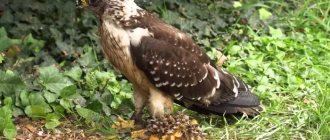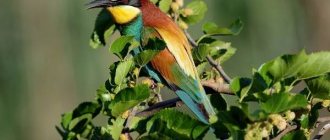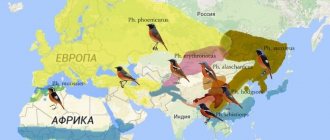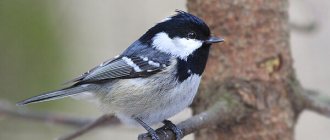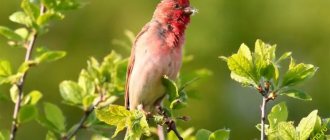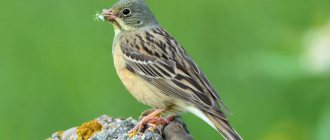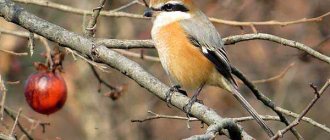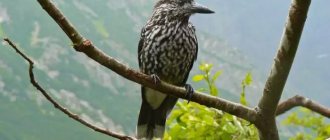- Wild animals
- >>
- Birds
The gray shrike is a truly unique bird that combines the ability to sing beautifully and the bloodthirstiness of a predator. The bird belongs to the order Passeriformes, but has nothing in common with the ordinary sparrow. This rather large songbird is divided into several species, and in this material we will mention all representatives of this family. In addition, we will tell you about the habits of this unusual bird and give many interesting features from its life.
Description of the bird
The shrike genus, numbering more than a dozen species, is widespread in Eurasia, Africa and North America. These birds are both songbirds and predators, such a rare and memorable combination.
The descriptions of all species of shrikes have common features: the birds are small in size, the length of the tail exceeds the length of the wing, and there is a “mask” of black feathers on the eyes. Their beak is quite large with a hook-shaped upper beak, like most birds of prey, which helps tear apart prey. The predominant colors are black, white, gray and red. Only a few southern species of shrikes are distinguished by brighter and more noticeable plumage. Females are usually a little lighter and more modest in color than males.
The prey is greater than the hunter
It's hard to believe, but a small 15-centimeter shrike is capable of killing an animal much larger than itself. Previously, this ability of birds surprised scientists. Looking at this miniature predator, producing sonorous trills, it is difficult to believe in the ability to hunt reptiles and mammals larger than itself. For this feature, shrikes received the Latin name Lanius, which means “executioner” or “butcher.”
Long-term observations of their behavior confirmed that the predator kills its prey with piercing blows of its beak to the neck or head. But until recently, it remained a mystery to ornithologists how such a relatively small bird could cope with much larger prey.
Shrike on the hunt
The researchers were able to establish the detailed mechanism of hunting only after long-term observations. As it turned out, after a successful throw and capture of the prey with its beak, the butcher bird begins to very quickly rotate the prey around itself. Under its own weight, the victim receives damage similar to strong blows with a stick. The rotation continues until the caught prey loses the last signs of life. Researchers described this feature of the shrike to finish off prey in the publication Biology Letters.
When hunting, the shrike's only weapon is its strong and powerful beak, curved at the edge in the form of a hook. The bird's legs are ordinary and, although equipped with claws, are not involved in obtaining food. Other birds of prey hold the caught animal with their claws, extinguishing resistance and killing the prey with their beak. The shrike uses its beak exclusively to spin its caught prey at surprisingly high speeds. The weight of the prey acts against itself - it dies from centrifugal rotation. This feature of hunting was also described by scientists from the Institute for Environmental Research, located at the San Diego Zoo in the United States.
Red-headed Shrike
What does it eat?
— Advertising —
Despite their melodiousness and modest size, shrikes are true predators. They feed not only on beetles, butterflies, spiders, caterpillars and other insects, but even small rodents, frogs, lizards, and small birds.
The shrike’s way of dealing with prey when it is large and the bird cannot eat it right away is interesting. In this case, the shrike impales, for example, a rodent on a thorn or sharp branch, and then tears off pieces as needed. By the way, it is precisely by these peculiar “traces” that the habitats of shrikes in nature are determined.
Gambling hunter
At the moment of attack, the shrike is overcome with intense excitement. There have been cases when frightened tits, hiding from pursuit, rushed towards a person, but even then the predator literally snatched the prey out of his hands. The bird grabs its prey with its claws and takes it to a place where it can calmly eat. These are dense bushes or trees. After this, the shrike strings the prey onto a twig and slowly plucks pieces from it. The skin of a wood mouse or shrew hanging on a tree is a sure sign that shrikes live in these places.
Common Shrike
Listen to the singing of the shrike
The audio tag is not supported by your browser. Close
Where does it live?
Each species of shrike is distributed in a specific area.
In general, their habitat is very wide, and does not only include Australia and South America. In all other parts of the world, one or another species of this bird is found. The shrike prefers to live in forest-steppe, bushes, groves and generally prefers open spaces with tall trees, which helps it in hunting.
Features of character and lifestyle
Photo: Gray shrike in nature
As mentioned above, the shrike is an aggressive predator that can hunt and kill without even feeling hungry. The bird is passionate and is able to pursue prey for a long time. In addition, the shrike has a very strong sense of its own territory. He will attack and drive away all the other birds that fly onto it. It often happens that a shrike attacks birds twice or even three times its size just to drive the uninvited guest out of the territory.
Fearlessness and aggressiveness help shrikes to tease large birds, attack them from different sides and force them to leave their own territory. Birds live in pairs and within their family they maintain very friendly and strong relationships. Shrikes are monogamous by nature and remain faithful to their partner throughout their lives. In addition, they are caring parents, nurturing their chicks for a long time.
Interesting fact: The bird got its name “shrike” from the ancient Slavic word “putit”, which means “to drive”. That is, literally translated, “shrike” means “drive a magpie,” and this perfectly characterizes the behavior of this bird.
Another important feature of these birds is that they can make migratory flights either in a flock of 50-80 individuals, or together (male and female). Moreover, throughout the journey, the shrikes support each other and the percentage of missing birds is extremely small.
Migratory or sedentary
— Advertising —
The seasonality of shrike migration depends on where the bird species lives. For example, residents of the northern regions, the gray shrike and the common shrike are migratory birds, and migrate south of their usual range for the winter. All other shrikes lead a sedentary lifestyle or are nomadic.
Habitat
Despite the fact that the number of these birds is small, their habitat is very wide.
The gray shrike inhabits in small quantities all of Europe, a large territory of Russia, and North Africa. In addition, the bird settles in some areas of South Asia up to the eastern line of India. Also, this bird, penetrating through Chukotka, stops near the forests of the USA and Canada. This bird species prefers to live in open areas. But, despite this, the shrike develops mountain territories, taiga and tundra. It can be noted that closer to the south this bird is nomadic, and representatives of the northern zones migrate for the winter.
Kinds
Shrikes are widely distributed and accordingly there are many species, including: Burmese Shrike, Rufous-tailed Shrike, Governor Shrike, Rufous-backed Shrike, Indian Shrike, Long-tailed Shrike, Philippine Shrike, Wedge-tailed Shrike, Grey-backed Shrike, Piebald Shrike, Somali Shrike, Attorney Shrike, Tibetan shrike, Newton's shrike.
The most famous shrike species include those listed below.
Gray Shrike
It is a large bird about the size of a thrush, with a large head, short wings and a long tail. Body length up to 40 cm, wingspan 35 – 39 cm, weight about 80 g.
From above, this species is ash-gray. Cheeks and chin are white. A wide black stripe, the so-called “mask,” runs across the eyes. The wings and tail are black with white spots. The beak of the gray shrike is large, black with a light base and a long hooked beak.
Desert Shrike
The desert shrike is slightly smaller and lighter than the gray shrike: its length is 25 cm, weight varies from 45 to 70 g. The plumage includes black, white and gray colors. The back is gray to black, the belly is light pink or light yellow. On the head along the eyes there is a wide black “mask”, characteristic of all shrikes.
Grey-shrike
It lives in the mountainous regions of Africa and reaches a length of about 25 cm. The back, neck and upper part of the head of this species are gray, the plumage of the chest and belly is white. The wings are black with a white spot. The tail is also black with a white stripe. The beak is hooked.
White-browed Shrike
The species is distributed in the tropical parts of Western and Central Africa at altitudes of 2200 m above sea level.
The body length is about 20 cm, about half of which is on the tail. Weight is about 35 g. The color of the plumage is the same as that of the gray-shriked shrike. The female is distinguished by brownish-red spots on her sides.
Black-fronted Shrike
A medium-sized species of shrikes: length 21–24 cm, wingspan 34–39 cm, weight about 60 g. The plumage is black and white with a pinkish tint on the belly. The Black-fronted Shrike is distinguished by its short tail and beak.
Red-headed Shrike
This species is medium in size: length about 19 cm, weight 30-50 g. Distinctive features of an adult male are a red cap of feathers on the crown and back of the head, a black “mask” on the eyes. The front of the back is black, the back is gray. The belly is white with a yellowish tint.
Masked Shrike
The bird reaches 17 cm in length. Its back is black. The plumage on the belly is white, the sides are orange-brown or reddish-brown. The black mask over the eyes is thin. Characterized by a long black tail.
Common Shrike
The common shrike nests in Europe and western Asia and flies to Africa for the winter.
Body length of these birds: 16-18 cm, wingspan: up to 30 cm, body weight on average 28 g. The back of males is reddish. The head is gray, and there is a black mask over the eyes. The abdomen is slightly pinkish, the tail is black and white. In females and young animals, the back is brown and the belly is dark yellow.
American shrike
The American Shrike is a resident of the North American continent.
In the southern regions it is a sedentary bird. But the population of the northern regions migrates south in winter. Very similar to the gray shrike, but differs in its large hooked beak. The plumage of the head and back is gray, and there is a black mask on the eyes. The wings and tail are black with individual white feathers.
Siberian Shrike
Distributed in arctic and polar regions. The length of an adult bird is up to 18 cm, average weight is 35 g. The plumage on the back is reddish-brown. On the eyes there is a black mask typical of the genus. The abdomen is creamy-white with a red tint, and there are pink feathers on the sides. The tail of the Siberian shrike is long, rounded at the end.
Tiger Shrike
This resident of East Asia resembles the common shrike in appearance. It is distinguished by brown with black stripes, “tiger” plumage on the back and tail, a massive beak and a black mask on the head. Females have no mask, the feathers on the head are gray.
Japanese shrike
The Japanese shrike lives in eastern Asia. Its body length is about 20 cm, its weight is up to 50 g. The tail and wings of this species are black, the back is gray, and the belly is red. The neck and head are also ocher in color with a black eye mask. Additionally, the Japanese shrike has a long, white-striped tail. The plumage of females and young animals is brown.
Voice
The male's song consists of short, euphonious trills interspersed with gurgling whistles, which is sometimes interpreted as “tu-tu-krr-prii-prii” or “trr-turit...trr-turit...”. In case of disturbance, in particular when a male or female of the same species appears on the territory, or when a large mammal approaches, it emits a long sharp whistle, something like a “buzzer.” To attract the attention of a female, the male often combines a similar whistle with a song. When communicating with each other, birds emit softer whistles “tryu-t”.
Keeping shrikes at home
A thrush cage or a spacious enclosure is suitable for a shrike.
Due to the aggressive nature of these birds, it is best not to house them with other species, especially small birds. If the shrike behaves restlessly, at first the cage is covered with a light-colored cloth. These predators must be fed using insects, beetles, and mealworms. The birds are pampered with beef and pieces of boiled egg.
It is important to clean your shrikes' cage regularly. If the bird does not bathe itself, you need to spray it with water from a spray bottle 2-3 times a week.
Breeding shrikes in captivity is possible if the pair of birds feels comfortable in the enclosure.
Social structure and reproduction
Photo: Gray Shrike in flight
In Russia, the nesting season for these birds begins in early May. The male sings the female's songs, bows rhythmically in front of her and flies around her in circles. Then he begins to build a nest and if the female has accepted the male’s advances, then they continue construction together. The bird nests in forest clearings, on the outskirts of large forests and even in forest belts in the steppes. The shrike's nest is also very interesting. It has two layers. The first layer is hard. It consists of thin twigs and dry grass. The second layer is soft and contains the chicks. Birds create it from the down, feathers and wool of their victims.
As a rule, there are up to 8 eggs in a shrike's nest. The female incubates them, and the male, in turn, fully supplies her with food. Hatching takes up to 15 days, and after this time the chicks hatch. Shrikes are very caring parents. They provide their chicks not only with food, but also with safety. One of the parents is always near the nest and is ready to protect the chicks from any predators.
The chicks' diet consists of insects. This diet is rich in protein, which helps the chicks develop in the shortest possible time. The chicks spend three weeks in the nest and then fly out, but their parents continue to feed them for a month. Moreover, even after flying, young birds maintain connections with their parents, and they often feed them with their supplies. There are often cases when children and parents formed a flock and flew away together for the winter.
Links[edit]
- ^ a b BirdLife International (2017). " Lanius Senator
(corrected version of 2016 assessment)."
IUCN Red List of Threatened Species
.
2017
: e.T22705095A118777394. DOI: 10.2305/IUCN.UK.2017-3.RLTS.T22705095A118777394.en. - Tony Harris and Kim Franklin (2000). Shrikes and bushes
. Helmet. ISBN 978-0-7136-3861-5. - Jobling, James A (2010). Helm's Dictionary of Scientific Names for Birds
. London: Christopher Helm. With. 219, 353. ISBN 978-1-4081-2501-4. - Woodchat. Oxford English Dictionary
(Online ed.). Oxford University Press. (Subscription or membership at a participating institution is required.) - "Shrike". Oxford English Dictionary
(Online ed.). Oxford University Press. (Subscription or membership at a participating institution is required.) - ^ abc Norbert Lefranc; Tim Warfolk (2013). Shrikes. A&C Black. pp. 159–165. ISBN 978-1-4081-8756-2.
